|
|
Post by olddutch on Nov 15, 2016 16:12:30 GMT -5
Thanks Martin,
Not meaning to pry - none of my business really, but I was impressed by the variety they offered.
I also have one that is unclassified. This would be a family heirloom because it could only have come from the herb garden of one of my late mother's aunts who passed away easily 3 decades ago. I found it growing feral in one of my sister's flower beds at the cottage where my mother's aunt and uncle had lived. I think this is a rocambole, but not really sure. The original bulbs that I collected were tiny, less across than a quarter, but still had half a dozen very tight cloves, which of course were really tiny. The bulbs have sized up pretty well over the past three years, though they are still on the small side, definitely not up the size of Music or Japanese. This one also has pea sized bulbils that almost invariably scape out and divide into true but very tiny bulbs the first year. A row of very tiny, almost delicately scaped plants from true bulbils. This one keeps quite well, especially in its smaller sizes. I store at very close to room temperature and have had plump plantable cloves into June of the following year, although few bulbs were completely that way. Most cloves had shriveled, but the average would be something like 1-3 good ones per bulb. The cloves have a rich red brown skin.
|
|
|
|
Post by steev on Nov 15, 2016 18:59:57 GMT -5
Glad to know that your grand-aunt passed away easily; we should all be so lucky.
|
|
|
|
Post by meganp on Nov 15, 2016 21:30:29 GMT -5
Thanks Martin, Not meaning to pry - none of my business really, but I was impressed by the variety they offered. I also have one that is unclassified. This would be a family heirloom because it could only have come from the herb garden of one of my late mother's aunts who passed away easily 3 decades ago. I found it growing feral in one of my sister's flower beds at the cottage where my mother's aunt and uncle had lived. I think this is a rocambole, but not really sure. The original bulbs that I collected were tiny, less across than a quarter, but still had half a dozen very tight cloves, which of course were really tiny. The bulbs have sized up pretty well over the past three years, though they are still on the small side, definitely not up the size of Music or Japanese. This one also has pea sized bulbils that almost invariably scape out and divide into true but very tiny bulbs the first year. A row of very tiny, almost delicately scaped plants from true bulbils. This one keeps quite well, especially in its smaller sizes. I store at very close to room temperature and have had plump plantable cloves into June of the following year, although few bulbs were completely that way. Most cloves had shriveled, but the average would be something like 1-3 good ones per bulb. The cloves have a rich red brown skin. Olddutch, do you recall the length of the beak on the umbel - the small bulb size and keeping qualities sound like they could be an Asiatic variety? |
|
|
|
Post by paquebot on Nov 16, 2016 0:50:15 GMT -5
Dutch, your volunteer is not a rocambole. if their bulbils produce a small divided bulb, it will be just a smaller version of a full-sized bulb. If the big bulbs have only 4 or 5 cloves, so too will the smaller ones, sometimes less. Combine your pea-size bulbils and first-year bulbs and that's typical of some purple stripes. A few years ago, Sand Hill was selling bulbils of a purple stripe which supposedly produced divided bulbs first year. A woman in Washington was also selling a similar one on forums with same claim. Both produced mostly rounds here and at the farm.
Martin
|
|
|
|
Post by reed on Nov 16, 2016 3:58:49 GMT -5
What do rounds look like inside? I ask cause it isn't uncommon in my garlic, keeping in mind I'v mostly let it grow basically wild and overcrowded. Anyway I'v often seen bulbs that are not divided by the paper skins but still when sliced you can see the individual cloves in cross section. I just thought they were not fully developed.
|
|
|
|
Post by blueadzuki on Nov 16, 2016 6:12:52 GMT -5
No those would still be considered divided. A round is all one clove. If you slice it crosswise you'd see a perfect circle of garlic flesh, with the green sprout in the center. Dutch, your volunteer is not a rocambole. if their bulbils produce a small divided bulb, it will be just a smaller version of a full-sized bulb. If the big bulbs have only 4 or 5 cloves, so too will the smaller ones, sometimes less. Martin That does not bode well for a lot of my garlic. Many of them only have two or three cloves per head. If it wasn't for the fact that I know I never got around to planting any before it spoiled, I'd swear that half of the stuff was longicuspis (which, as far as I can tell, never gets more than about four cloves ever). And it's stayed like that for years (actually what tends to happen with our variable conditions is that garlic tends to go into an extended version of the multi year plan, with the rounds going back and forth in sizes over the years until we get two good seasons in a row and some of them finally divide. I dunno, maybe if I ever get three or more good garlic years in a row the stuff might reach respectable size (the heads are currently at that golf ball size you mention) Then of course there's the one that divides into 16 cloves when it hits quarter size, and never gets any bigger (if you plant it after that, most of the smaller cloves don't have the stored food to make it through and die without making anything and what you get is a little circle of four or five tiny plants which will again make pea sized rounds) |
|
|
|
Post by paquebot on Nov 16, 2016 10:02:21 GMT -5
A divided bulb is one that has individual cloves, each with their own separate skins. A round has just one skin just inside the outer wrapper. Started from bulbils, there may be bulbs barely an inch wide and comprised of 4 or 5 cloves. At same time, other varieties may produce a round 1½" wide.
There are varieties which only produce an average of 4 cloves. If that's all one gets consistantly, than that's probably one of them.
Martin
|
|
|
|
Post by olddutch on Nov 16, 2016 16:22:27 GMT -5
Martin,
I am no expert so here is a more complete description:
Original collection was in mid-July of fully scaped plants with pea sized bulbils.
Location was in extreme NW Iowa fully zone 4.
The collected bulbs they grew out of were very small, hardly a diameter of about a nickle to a quarter but had 7 or 8 very tiny cloves.
The cloves planted in well prepared beds that fall produced bulbs with some 7-10 cloves and about half again the diameter of the initially collected bulbs.
The scapes were removed the first year.
The first year the collected bulbils produced some very few rounds but mostly much smaller but fully scaped plants with divided bulbs than the cloves did. Those scapes were also removed.
The third year was all cloves. Once again the bulb size increased in direct proportion to how well the bed was prepared. This time one part of the bed was allowed to scape out for bulbils and another part was not. The resulting scapes were curled in some cases at least twice with a very standard type of beak (not the extended Asiatic type that I get from my Japanese). Biggest bulb size was just under and inch and a half for those where the scapes had been removed. The ones left to produce bulbils were hardly half the size of the others.
The forth year I got an early blow down from a major wind storm and so a very early maturation and harvest with only some bulbs now up to around an inch and a half. The bulbils that year all sent up scapes but on delicate little plants, much smaller versions of those grown from cloves and none of them produced true rounds, but most only had a couple or three very tiny cloves.
Inside clove wrappers up against the meat are a dark reddish brown. The clove size is small with 8 to 10 cloves in a single row around the scape stem.
This variety keeps much better than Japanese Red for example, and at least as good as Siberian, but eventually the cloves dry out in the bulb and shrink away from the wrappers. However, not all of them do that uniformly. There is also quite a difference in keeping period between the smallest and the largest bulbs. The bigger the bulb the quicker it loosens up.
Two years ago I had a set of scattered cloves that were still plump, although most of those on all the bulbs were dried out and shrunken. I planted those cloves in early June and they all sprouted. They did not scape out nor did they go dormant but stayed upright and green all winter. They did scape and produce cloved bulbs the next summer. Note that I do not store my garlics cool, but rather in a corner of my kitchen which runs about mid 60's but seldom less in the winter. I very seldom get sprouters at any time, but cloves rather tend to dry out and shrivel up. Last summer's harvest was in early July, the bulbs I still have are tight but once broken the cloves often come away already partially peeled. Even the small cloves tend to pop right out of the brown husk once the bulb is broken apart.
The very tiny initial bulbs and the first year ones from bulbils are very tight and stay that way into winter, BUT the eventual larger bulbs that I have gotten come apart much easier and get loose much quicker.
So whatever it is, rocambole is simply my guess. It is a family heirloom and I will keep it. It may actually have come from Germany as long ago as the 1930's or earlier. It has not gotten large - for that I grow Music and Japanese both of which also produce much, much larger (and fewer) cloves. I also grow Siberian, Vietnamese Red, and Xian. Besides I do have some true sand leeks and those are delicate little things and very easy and a few (very few) elephants, which do not do so well for me.
This feral also seems to tolerate heavy soils very well. That is where it grew feral all by itself in a solid clay based loam in NW Iowa for something like 30 years.
If it is any help, my mother's relatives are German Mennonitish by ancestry. The late aunt was infact born in Germany probably somewhere in the south close on the Swiss border (Wurtemberg, Swabia??). She was quite an herbalist. There are some shirt tail relations into some of the Amish. I don't know if they have any tendencies about what kinds of garlic they grow, it doesn't seem so from what I have read beyond having kept a number of heirloom types for a very long time.
BTW the taste raw is sorta hot that grows until it burns in the back of one's throat as you swallow it and then the taste lingers for quite awhile. I am not any kind of gourmet and I normally only use my garlic in cooking; so take that with whatever grain of salt is appropriate.
|
|
|
|
Post by meganp on Dec 12, 2016 4:34:00 GMT -5
An update on my turban garlic rounds that were planted in SH autumn. Very mild winter with only a couple of days of snow cover and every one of the rounds failed to divide, just grew bigger. Usually keep the bigger ones to replant again but could resist eating a couple of them  This was taken at the time that they were planted 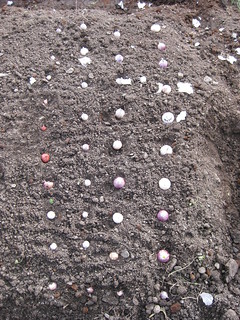 IMG_6801 IMG_6801 by meganp08, on Flickr what was harvested 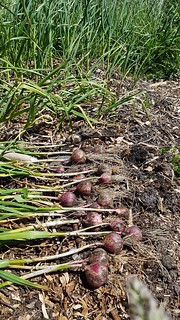 20161210_151052 20161210_151052 by meganp08, on Flickr 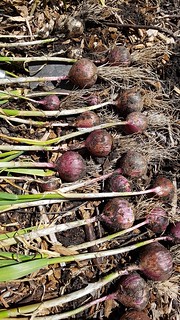 20161210_151108 20161210_151108 by meganp08, on Flickr Dinner  reed reed , you were asking what a round looks like inside - the rounds are the two with a cross cut in them 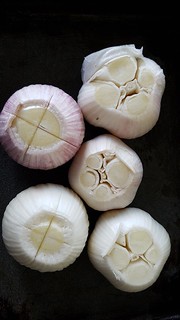 20161210_165927 20161210_165927 by meganp08, on Flickr |
|
|
|
Post by richardw on Dec 12, 2016 13:27:27 GMT -5
I'm starting to think that Todd's bulbils will give me rounds Megan, fingers crossed.
|
|
|
|
Post by meganp on Dec 29, 2016 4:53:21 GMT -5
Have you harvested Todds garlic yet? Did you get any rounds? Will show you mine if you show me yours😉
|
|
|
|
Post by richardw on Dec 29, 2016 15:11:22 GMT -5
Yes like all my beds some had rotted from botrytis but most were fine.  An impressive round out of the TGS block  |
|
|
|
Post by meganp on Jan 2, 2017 15:59:39 GMT -5
Have harvested less than a 1/4 of this year's garlic - most of the turbans and still culling any maincrop plants with botrytis  Here are the rounds that I've lifted so far - a few still in the ground but pleased with the results so far. The stems of the rounds are really thin so any that break have been put in an onion bag - 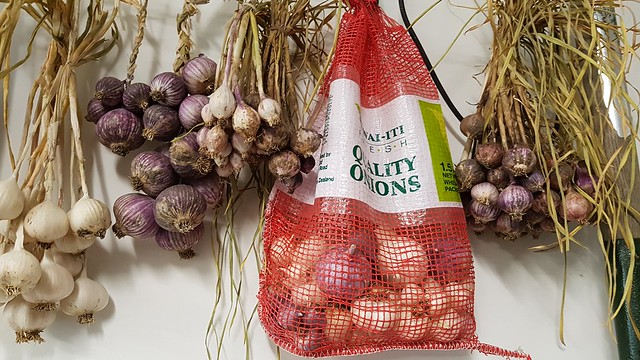 20170103_091412 20170103_091412 by meganp08, on Flickr 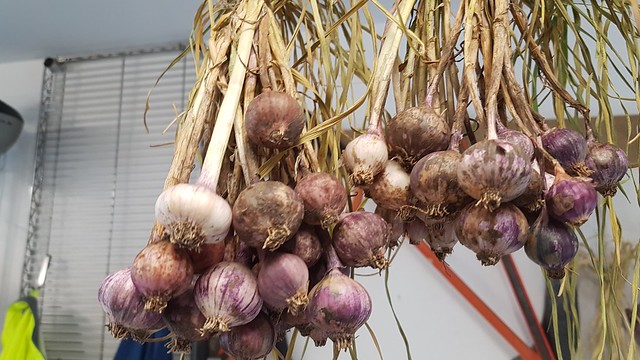 20161230_125828 20161230_125828 by meganp08, on Flickr here's one of the bigger ones 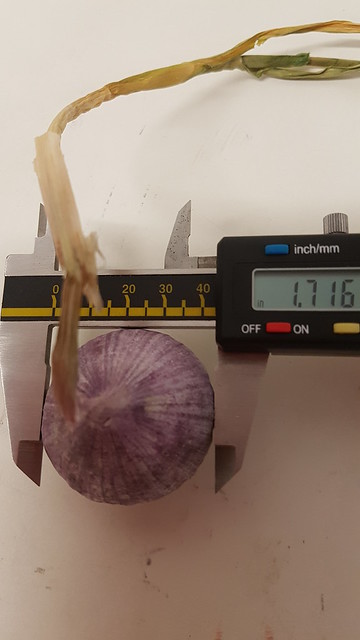 20161226_192643_001 20161226_192643_001 by meganp08, on Flickr I won't bother splitting this wee bulb - it will be replanted as is and ought to revert to rounds next season  20170103_094531 20170103_094531 by meganp08, on Flickr at the bottom of this photo are three rounds that grew from a small three cloved bulb like the one in the photo above. 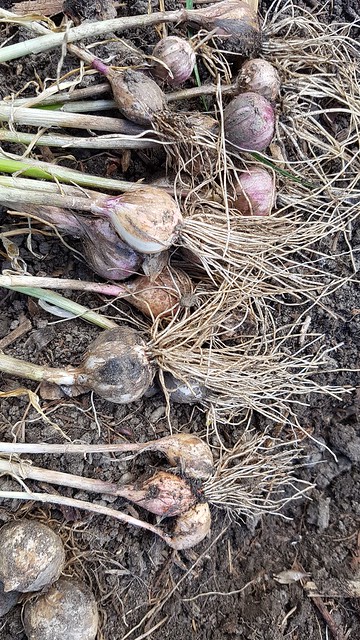 20170101_171347 20170101_171347 by meganp08, on Flickr |
|
|
|
Post by richardw on Jan 2, 2017 16:22:25 GMT -5
Bloody hell!!, how do you do it??, those rounds are huge.
|
|
|
|
Post by meganp on Jan 2, 2017 17:29:05 GMT -5
I have no idea! The really big ones are into their third season and they are mostly turbans, the early harvesting variety that aren't any good for true seed. The normal sized rounds are possibly marbled purple stripes and rocamboles.
|
|